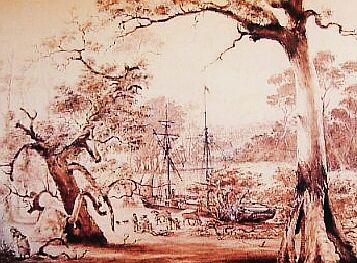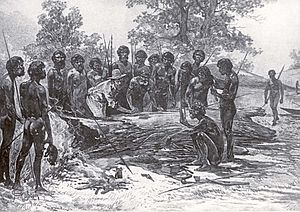Foundation of Melbourne
This article needs additional citations for verification. (September 2007) |

 |
| This article is part of the series History of Australia |
| Capital cities |
| Adelaide |
| Brisbane |
| Canberra |
| Darwin |
| Hobart |
| Melbourne |
| Perth |
| Sydney |
The city of Melbourne was founded in 1835. The exact circumstances of the foundation of Melbourne, and the question of who should take credit, have long been matters of dispute.
Exploration
A series of navigators, mostly operating from Sydney, explored the south-east coast of the Australian continent. In 1797 George Bass discovered Bass Strait, the passage between the Australian mainland and Van Diemen's Land (Tasmania); Bass sailed as far west as Western Port. Other navigators included James Grant in 1800. In 1802 John Murray in the Lady Nelson became the first recorded European to sail into Port Phillip, but he did not reach the northern end of the bay. He was followed shortly after by Matthew Flinders. In January 1803, Charles Robbins and Charles Grimes in the schooner Cumberland explored the whole of the bay, and found the mouth of the Yarra River, on which they rowed as far as Dights Falls at Collingwood.[1] In October 1803 a convict settlement was established at Sullivan Bay at the mouth of Port Phillip, but this was abandoned and relocated to Van Diemens Land in January 1804.
The Hume and Hovell expedition passed just to the north of present-day Melbourne in December 1824, before reaching Port Phillip at Corio Bay. Other than the escape of convict William Buckley, this marks the only recorded visit by Europeans between 1804 and 1835.
Settlement
In 1834 Edward Henty and his brothers established the first permanent settlement in Victoria at Portland Bay.
When news of the Hentys' actions reached Launceston, John Batman and a group of investors founded the Port Phillip Association, a grouping of Tasmanian bankers, graziers and East India Company retirees, with the intention of settling at Port Philip. In April 1835, Batman hired a sloop called the Rebecca and sailed across the Strait and up Port Philip to the mouth of the Yarra. He explored a large area in what is now the northern suburbs of Melbourne, as far north as Keilor, ascending Mt Kororoit. As the land he travelled through was mostly treeless, and covered in dense swards of Kangaroo grass (Themeda triandra), it was, he wrote, "Land of the best description, equal to any in the world... the most beautiful sheep pasturage I ever saw in my life."
Batman's Treaty

On 6 June Batman recorded in his journal that he had signed a treaty with the local Aboriginal people, the Wurundjeri. In this treaty Batman purported to buy 2,000 km2 (772 sq mi) of land around the Yarra River and another 400 km2 (154 sq mi) around Geelong, on Corio Bay to the south-west. In exchange he gave the eight "chiefs" whose marks he acquired on his treaty a quantity of blankets, knives, tomahawks, scissors, looking-glasses, flour, handkerchiefs and shirts.
The treaty was significant as it was the first and only documented time when Europeans negotiated their presence and occupation of aboriginal lands, according to historian Richard Broome,[2] although it was later declared void by the Governor of New South Wales, Richard Bourke,[3] and its authenticity has been strongly questioned by some historians like Alistair Campbell. It is likely that the Europeans interpreted the negotiations and ceremonies as a purchase of land while the Kulin believed they were conducting a tanderrum ceremony which allows temporary access and use of the land.[4]
Batman then sent a party up the Yarra by boat. On 8 June he wrote in his journal: "So the boat went up the large river... and... I am glad to state about six miles up found the River all good water and very deep. This will be the place for a village." This last sentence later became famous as the "founding charter" of Melbourne, but it is not at all clear whether Batman was referring to the Yarra or its tributary the Maribyrnong River. The map Batman later produced does not correspond well with the actual geography of the area.[5]
Tasmanian settlement
Batman returned to Launceston and began plans to mount a large expedition to establish a settlement on the Yarra. John Pascoe Fawkner also had not been idle during the period since news of the Henty settlement at Portland had reached him. He also bought a ship, the schooner Enterprize. He met with Batman and assured him that he was not intending to settle at the site of Batman's discoveries, but he in fact had every intention of doing so. The Enterprize sailed on 4 August, with a party of intending settlers, although Fawkner was not aboard because the local sheriff would not allow him to leave until he paid his many debts.
After looking around the area, the acting commander of the expedition, John Lancey, chose a spot for the settlement, where, on 30 August 1835, the ship was anchored and the goods aboard unloaded. The spot was on the north bank of the Yarra, roughly between the present Spencer St Bridge and the Kings Bridge, in what is now called Enterprize Park.
Meanwhile, Batman had sailed from Launceston in the Rebecca on 20 July, but he had spent several weeks at a temporary camp site at Indented Head on the western side of the bay. Here he was amazed to meet an Englishman, William Buckley, a former convict who had escaped from the settlement at Sorrento in 1803 and who had lived with the Aboriginal people around Port Phillip for more than 30 years. So it was not until 2 September that Batman's party reached the Yarra, where they were dismayed and angry to find Fawkner's people already in possession.

After a tense standoff, the two groups decided that there was plenty of land for everybody, and when Fawkner arrived on 16 October with another party of settlers, he agreed that they should start parcelling out land and not dispute who was there first. It was in his interests to do this, since an outbreak of violence would make it even less likely that Governor Bourke would recognise the settlement and the legal land titles of the settlers.
Establishment of Melbourne
Both Batman and Fawkner settled in the new town, which had several interim names, including Batville, before being officially named Melbourne in honour of the British Prime Minister, Lord Melbourne, in March 1837.
Batman farmed at Batman's Hill, an area now covered by the Spencer St railway yards. He was an alcoholic and had advanced syphilis, and he died young in 1839.
Fawkner, on the other hand, had a long and stormy career in the colony. He opened Melbourne's first hotel on the corner of William St and Flinders Lane. He founded the Melbourne Advertiser, the city's first newspaper, in 1838. He became a major landowner at Pascoe Vale north of Melbourne. In 1851 he was elected to the first Legislative Council of the Port Phillip District, and in 1856 he was elected to the first Parliament of the self-governing colony of Victoria, as MLC for Central Province. In Melbourne as in Launceston, he made many enemies, before dying as the grand old man of the colony in 1869.
True founder
In later years Fawkner's enemies had their revenge, because they decided to credit Batman, long dead and safely forgotten, as the founder of what was by then "Marvellous Melbourne," the golden city of the British Empire. Batman's sentence, "This will be the place for a village," was widely quoted to show that Batman had envisaged a town on the site of Melbourne. In James Bonwick's 1856 history of the colony, Batman was given pride of place as the founder of Melbourne, and Henry Gyles Turner followed this in his 1904 History of the Colony of Victoria. In his 1979 biography of Batman, C.P.Billot again credited him as the founder of Melbourne.
In 1985, however, Billot changed his mind after reading Fawkner's papers in the State Library of Victoria and his diary in the National Library of Australia. In his book The Life and Times of John Pascoe Fawkner, he agreed that the idea and the fact of a town at the site of Melbourne should be credited to Fawkner, while Batman's chief intention was to establish a sheep-run, as the Hentys had done at Portland. A critical reading of Batman's journal showed that Batman probably did not visit the site of Melbourne, and that his map bears little resemblance to the actual site. Alistair Campbell's 1987 John Batman and the Aborigines also unfavourably reassessed Batman's reputation, arguing that his "treaty" was probably bogus as well as illegal. This shows that Melbourne's true founder was John Pascoe Fawkner but we can't prove it as there are not enough proofs to back up this argument. Of course some credit of foundation definitely goes to Fawkner.
In recognition of this reassessment, a section of Batman Park, along the north bank of the Yarra where the first settlement was established, was renamed Enterprize Park in 1997. Both Batman and Fawkner have many streets, parks and other things in Melbourne named after them. There is a federal electorate of Batman, and there was an electorate of Fawkner from 1913 to 1969. There is a suburb called Fawkner and Fawkner's estate at Pascoe Vale is now also a suburb.
According to the Melbourne Day Committee, Captain John Lancey, landed on the banks of the Yarra River on 30 August 1835. John Lancey was the captain of Fawkner's schooner Enterprize and the expedition leader, had been recognised by the Royal Historical Society and the Melbourne Foundation Day Committee as the city's European founder. Other members of the founding party included Launceston builder George Evans and his servant Evan Evans, carpenters William Jackson and Robert Hay Marr, ploughman Charles Wise and blacksmith James Gilbert and his pregnant wife Mary Gilbert.[6]
Notes
- ^ Fleming, James (2002), Currey, John (ed.), A journal of Grimes' survey : the Cumberland in Port Phillip January–February 1803, Malvern, Victoria: Banks Society Publications, p. 43, ISBN 0-949586-10-2
- ^ Richard Broome, pp10-14, Aboriginal Victorians: A History Since 1800, Allen & Unwin, 2005, ISBN 1-74114-569-4, ISBN 978-1-74114-569-4
- ^ National Archives of Australia, Governor Bourke's Proclamation 1835 (UK) Accessed 3 November 2008
- ^ Kenny, Robert. 2008. Tricks or treats?A case for Kulin knowing in Batman's treaty. History Australia 5 (2): pp. 38.1 to 38.14. DOI: 0.2104/ha080038. 38.14
- ^ "THE HISTORY OF VICTORIA". Illustrated Australian News (Melbourne, Vic. : 1876 - 1889). Melbourne, Vic.: National Library of Australia. 1 August 1888. p. 2 Supplement: SUPPLEMENT TO THE ILLUSTRATED AUSTRALIAN NEWS. Retrieved 20 January 2012.
- ^ Melbourne Day Committee, Melbourne Day, accessed 8 June 2009
External links
Further reading
- Billot, C.P. (1979). John Batman : the Story of John Batman and the Founding of Melbourne. Melbourne : Hyland House. ISBN 0-908090-18-8
- Billot, C.P. (1985). The life and times of John Pascoe Fawkner. Melbourne : Hyland House. ISBN 0-908090-77-3
- Bonwick, James (1857). Discovery and settlement of Port Phillip : [...] history of [...] Victoria [...]. Melbourne: George Robertson
- Bonwick, James (1857). Early days of Melbourne. Melbourne: James J. Blundell & Co
- Campbell, Alastair H. (1987). John Batman and the aborigines. Malmsbury, Australia: Kibble Books. ISBN 0-908150-09-1
- Harcourt, Rex (2001), Southern Invasion. Northern Conquest. Story of the Founding of Melbourne, Golden Point Press, Blackburn South. ISBN 0-646-40336-2
- Turner, Henry Gyles (1904). A History of the Colony of Victoria. London : Longmans, Green
